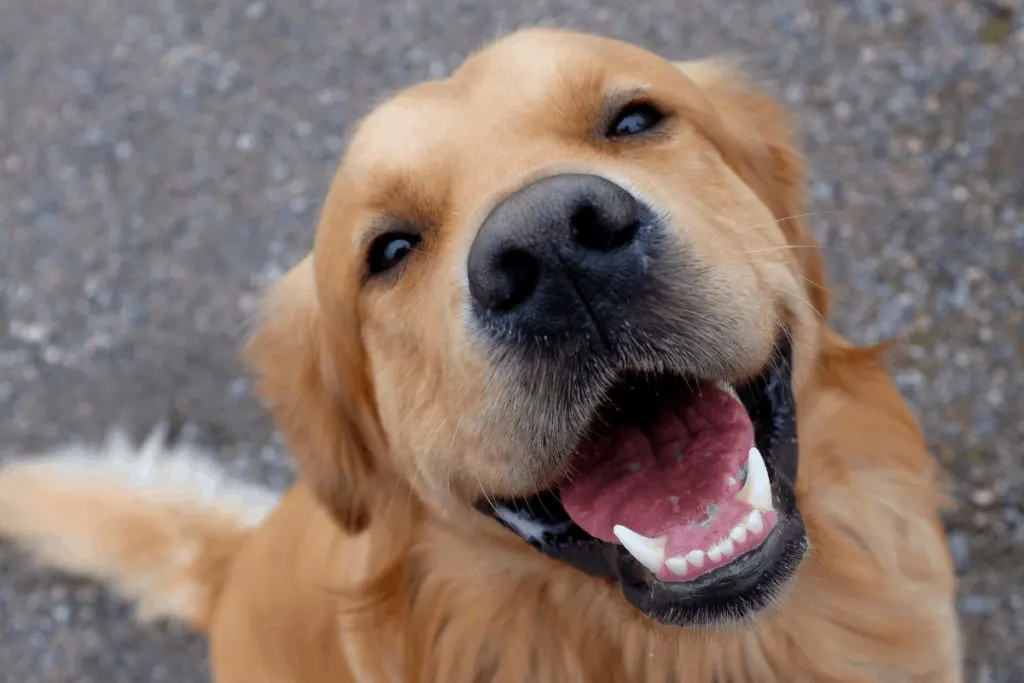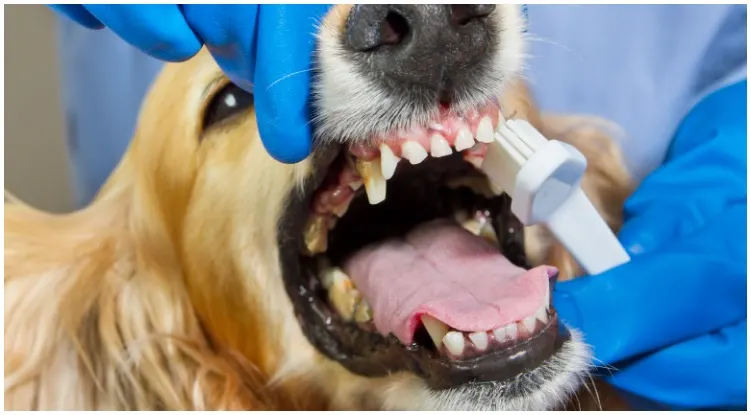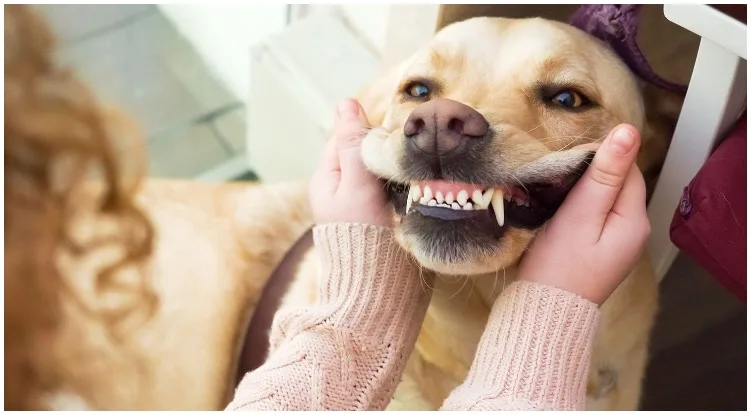Just like you wouldn’t neglect your own teeth, you shouldn’t neglect the ones of your dog as well. Undoubtedly, good dental health is incredibly important to the overall health of our furry friends. Therefore, you might wonder what’s the first step of taking care of your dog’s oral hygiene? Educating yourself. What do you even know about dog teeth? If you need some basic knowledge, this article is just right for you. We’ll go over the basics such as how many teeth do dogs have or what you can do to take care of their teeth.
But if you’re more interested in learning how to brush your dog’s teeth correctly, then this article is just right for you.
How many teeth do dogs have?
Puppies, of course, start out with temporary teeth. Just like we do. Eventually they start falling out while your dog’s adult teeth start growing out.
Puppies have 28 milk teeth, and they begin to appear two weeks after their birth. Puppy teeth completely grow out 8 to 10 weeks later.
If you ever owned a puppy, you know that these teeth are razor sharp. Pups love to bite your fingers with them and will take any chance they possibly get to chew on ANYTHING. But there is a reason why their milk teeth are so sharp. Puppies need a little extra help with chewing, as their jaws clearly aren’t as strong as the jaws of adult dogs.
Dogs loose their milk teeth very quickly. The first ones start falling out after about four months. Finally, their adult teeth start growing out at about 5-6 months of age. Lastly, after the premolars and molars grow out at about 7-8 months of age, your dog will have a total of 42 adult teeth. If by any chance your dog’s milk teeth didn’t fall out completely, you’ll need to visit a vet.

What are the four types of dog teeth?
Adult dogs have four different types of teeth. All of them have a specific purpose. Since they need different types of teeth for different functions while eating.
Incisors
These are the small teeth in the front of your dog’s mouth. They have a total of 12 incisors, 6 on the top, and six on the bottom. Their purpose is to tear food up, like tearing meat from bone.
Canines
The pointy teeth that your dog has on each side of it’s mouth are called canines. We also refer to them as fangs. They have two on the top and two on the bottom. Their purpose is to puncture and hold onto something.
Premolars
These are the ones found behind the canine teeth. They have a total of 16, 8 on the top and 8 on the bottom. Their main purpose is to grind the food up.
Molars
The molars teeth are found in the back of the mouth and dogs have a total of 10. 4 on the top and 6 on the bottom. They are used for chewing the food up.

How to take care of your dog’s teeth
A healthy pair of teeth will highly increase the overall health of your canine friend. Schedule dental check ups at least once a year, and brush them regularly. You don’t have to do it twice your day, like you brush your own, but ideally, you should try to do it once. Best would be at night after your pup had his dinner.
But don’t try to do it with a regular human toothbrush and toothpaste. These are way too harsh for dogs. Buy a specially made dog toothbrush and dog toothpaste. These are available at pretty much any pet store.
Poor dental hygiene could lead to serious health problems. Gum and tooth infections aren’t too rare in dogs, and as a result of that many senior dogs have trouble eating food. Chewing starts to become difficult, and excessive drooling becomes a problem as well. Lastly, your dog might won’t be able to eat hard food at all.
Another huge side effect of poor oral hygiene is also bad breath. That is not something you want to experience as well when you are close to your dog cuddling on the couch, right?
Contact your vet if you suspect that your dog has started losing teeth. It might be a sign of a much more serious condition such as periodontal disease. We will talk more about this condition in the next part of the article.
What can cause my dog to lose teeth?
Aside from the change from puppy to adult teeth, a dog’s teeth do not usually fall off. If you find your dog’s adult teeth are falling out, you should contact your veterinarian to make an appointment.
Sure, there are some reasons why dog teeth could fall off. Just like humans can lose teeth as well. But if you take good care of your dog and his dental hygiene, that shouldn’t really happen until he reaches an older age.
The following are the most prevalent causes for a dog’s adult teeth to fall out.
Periodontal disease
You already know that you have to brush your own teeth at least twice a day. However, you also have to brush your dog’s teeth, ideally, every night after he had his dinner. If you don’t, he could develop periodontal disease. And this is actually the most common reason why dogs lose their teeth.
Periodontal disease can lead to damaged gums and decayed teeth if proper dental care is not provided, such as brushing and veterinary dental cleanings. So make sure you buy a dog toothbrush and toothpaste, and get down to business and brush your dog’s teeth once a day.
The normal process through which your dog’s body rejects a rotting tooth is unpleasant and painful, and it can lead to a life-threatening illness in severe situations.
Systemic effects on organs such as the heart, liver, and kidneys have also been linked to dental illness. If the bacteria in a dog’s mouth becomes severe, it can cause infections elsewhere in the body.
Tooth decay
Dogs’ teeth rot and wear out faster than ours, which is partly owing to the fact that they utilize their mouths for purposes other than eating and drinking. Their mouths are basically their arms and hands as well.
Picking up, carrying, and chewing are all done using their teeth. Slobbery toys, hair, dirt, feces, and food are just a few of the items that travel through a dog’s mouth. All of this can have a negative impact on their dental health.
Tooth decay strikes some dog breeds at an alarming rate, necessitating the extraction of numerous teeth by a veterinarian during the course of their lives. Some dog breeds are especially prone to tooth decay, such as Chihuahuas and Greyhounds.
Your veterinarian will likely recommend a professional cleaning under general anesthesia, along with the extraction or removal of any damaged teeth, to treat decaying teeth. This is a routine technique performed by animal hospitals on a daily basis.
The appropriate removal of a diseased tooth, rather than leaving it as a cause of discomfort and infection in their mouth, is considerably more comfortable for a dog’s mouth. Surprisingly, dogs can eat without their teeth if necessary.
Trauma
Your dog’s teeth can be lost as a result of trauma, whether it’s from eating something or from another type of oral injury. This is one of the most common ways that dogs, especially younger dogs, lose teeth.
Your dog could hurt its teeth in many different ways. For example, if he has a stainless dog bowl, and eats his food way too aggressively. If he gets in a fight with other dogs, or if he bites on hard food such as bones. This breaks teeth, and they eventually fall off.
To preserve your dog’s teeth, avoid offering him beef or pork bones, as this material is excessively hard and can cause fractures and tooth damage.
Once one of your dog’s teeth is gone, it’s gone for good. And just like you need your own teeth, your dog needs his as well. A good set of healthy teefies will preserve his quality of life over the years.
Final words
Now that you know what the final number of dog teeth is, the only thing you as a pet owner will have to do is make sure that this number stays the same. And you will do that by making sure your dog’s oral hygiene is on point. And the best way to do that is by persistent tooth brushing and taking him for an oral exam at the vet technician at least once a year. This will prevent periodontal problems, and help your dog keep his teeth during his lifetime.
Different breeds especially small breed dogs are especially good candidates for dental problems. Severe cases of diseased gums could even put the overall health of your pup at great risk. While it is a persistent belief that the natural process of life will have a tool on a dogs mouth, oral hygiene and knowing the clinical signs of dental problems, will for sure help your dog’s teeth to preserve their own function.
So start brushing their teeth while your puppy is only weeks of age, and make sure you clean both the upper jaw and lower jaw with a gentle and small dog brush. Small pieces of food can get trapped, and if you don’t brush their teeth daily, these food leftovers could easily develop into cavities.

